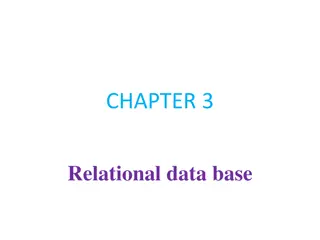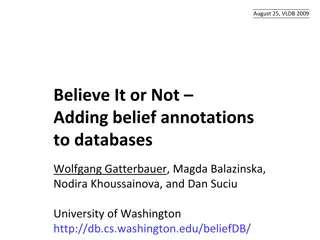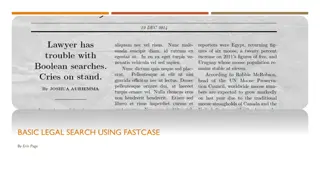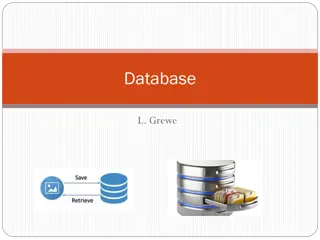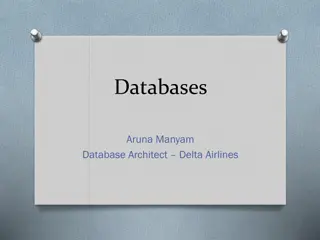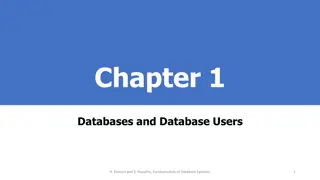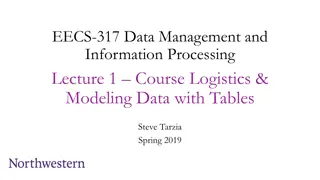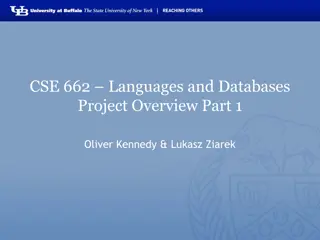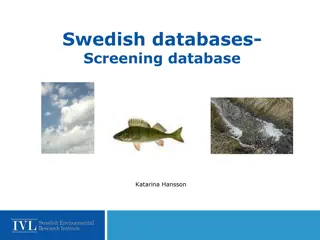Understanding Views in Databases
Views in databases are logical tables that provide various advantages such as enhanced security and data independence. They allow users to manipulate and retrieve data easily, while simplifying complex queries. This article explores the concept of views, their advantages, types, and how to create them using SQL statements.
Download Presentation

Please find below an Image/Link to download the presentation.
The content on the website is provided AS IS for your information and personal use only. It may not be sold, licensed, or shared on other websites without obtaining consent from the author. Download presentation by click this link. If you encounter any issues during the download, it is possible that the publisher has removed the file from their server.
E N D
Presentation Transcript
Chapter 2 Views
Objectives Create simple and complex views Creating a view with a check constraint Retrieve data from views Data manipulation language (DML) operations on a view Dropping a view
Database Objects Object Description Table Basic unit of storage; composed of rows View Logically represents subsets of data from one or more tables Sequence Generates numeric values Index Improves the performance of data retrieval queries Synonym Gives alternative names to objects
What Is a View? EMPLOYEES table
What Is a View? A view is a logical table based on a table or another view A view contains no data of its own, but its like a window through which data from tables can be viewed or changed The tables on which a view is based are called base tables
Advantages of Views Security: views prevent undesired access by providing security as the data that is not of interest to a user can be left out of the view. Views are usually virtual and occupy no space. Display different data for different types of users. Simplicity: Complex queries that need to be executed often can be saved in a view. Hence by calling the view name, query can be executed.
Advantages of Views Independence: View can make the application and database tables to a certain extent independent. If there is no view, the application must be based on a table. With the view, the program can be established in view of above, to view the program with a database table to be separated. One view can be used to represent data from several tables
Simple Views and Complex Views Feature Simple Views Complex Views Number of tables One One or more Contain functions No Yes Contain groups of data No Yes DML operations through a view Yes Not always
Creating a view You embed a subquery in the CREATEVIEW statement: CREATE [OR REPLACE] [FORCE|NOFORCE] VIEW view [(alias[, alias]...)] AS subquery [WITH CHECK OPTION [CONSTRAINT constraint]] [WITH READ ONLY [CONSTRAINT constraint]]; The subquery can contain complex SELECT syntax.
Creating a view Create the EMPVU80 view, which contains details of the employees in department 80: CREATE VIEW empvu80 AS SELECT employee_id, last_name, salary FROM employees WHERE department_id = 80; Describe the structure of the view by using the iSQL*Plus DESCRIBE command: DESCRIBE empvu80
Guidelines The sub query that defines a view can contain complex SELECT syntax, including Joins ,groups and Subqueries If you don t specify a constraint name for the view created with the WITH CHECK OPTION, the system assigns a default name You can use the OR REPLACE option to change the definition of the view without droping and re- creating it , or re-granting the object privileges
Creating a View Create a view by using column aliases in the subquery: CREATE VIEW salvu50 AS SELECT employee_id ID_NUMBER, last_name NAME, salary*12 ANN_SALARY FROM employees WHERE department_id = 50; Select the columns from this view by the given alias names.
Creating a View Another way to use aliases : CREATE OR REPLACE VIEW salvu50 (ID_NUMBER, NAME, ANN_SALARY) AS SELECT employee_id, last_name, salary*12 FROM employees WHERE department_id = 50;
Retrieving Data from a View SELECT * FROM salvu50; You can display all the content of a view or specify selected column from the view.
Modifying a View Modify the EMPVU80 view by using a CREATE ORREPLACEVIEW clause. Add an alias for each column name: CREATE OR REPLACE VIEW empvu80 (id_number, name, sal, department_id) AS SELECT employee_id, first_name || ' ' || last_name, salary, department_id FROM employees WHERE department_id = 80; Column aliases in the CREATEORREPLACE VIEW clause are listed in the same order as the columns in the subquery.
Creating a Complex View Create a complex view that contains group functions to display values from two tables: CREATE OR REPLACE VIEW dept_sum_vu (name, minsal, maxsal, avgsal) AS SELECT d.department_name, MIN(e.salary), MAX(e.salary),AVG(e.salary) FROM employees e JOIN departments d ON (e.department_id = d.department_id) GROUP BY d.department_name; Note that alternative names have been specified for the view. This is a requirement if any column of the view is derived from a function or an expression.
Rules for Performing DML Operations on a View You can usually perform DML operations on simple views. You cannot remove a row if the view contains the following: Group functions A GROUPBY clause The DISTINCT keyword The pseudocolumn ROWNUM keyword
Rules for Performing DML Operations on a View You cannot modify data in a view if it contains: Group functions A GROUPBY clause The DISTINCT keyword The pseudocolumn ROWNUM keyword Columns defined by expressions (for example, SALARY * 12).
Rules for Performing DML Operations on a View You cannot add data through a view if the view includes: Group functions A GROUPBY clause The DISTINCT keyword The pseudocolumn ROWNUM keyword Columns defined by expressions NOTNULL columns in the base tables that are not selected by the view without default values in the base table Remember that you are adding values directly to the underlying table through the view.
Using the WITHCHECKOPTION Clause You can ensure that DML operations performed on the view stay in the domain of the view by using the WITHCHECKOPTION clause: CREATE OR REPLACE VIEW empvu20 AS SELECT * FROM employees WHERE department_id = 20 WITH CHECK OPTION CONSTRAINT empvu20_ck ; Any attempt to INSERT a row with a department_id other than 20, or to UPDATE the department number for any row in the view fails because it violates the WITHCHECKOPTION constraint.
Using the WITHCHECKOPTION Clause The WITHCHECKOPTION clause specifies that INSERTs and UPDATEs performed through the view cannot create rows that the view cannot select. Therefore it enables integrity constraints and data validation checks to be enforced on data being inserted or updated. If there is an attempt to perform DML operations on rows that the view has not selected, an error is displayed, along with the constraint name if that has been specified. UPDATE empvu20 SET department_id = 10 WHERE employee_id = 201; causes: ERROR
Using the WITHCHECKOPTION Clause No rows are updated because, if the department number were to change to 10, the view would no longer be able to see that employee. With the WITHCHECKOPTION clause, therefore, the view can see only the employees in department 20 and does not allow the department number for those employees to be changed through the view.
Denying DML Operations You can ensure that no DML operations occur by adding the WITHREADONLY option to your view definition. Any attempt to perform a DML operation on any row in the view results in an Oracle server error.
Denying DML Operations CREATE OR REPLACE VIEW empvu10 (employee_number, employee_name, job_title) AS SELECT employee_id, last_name, job_id FROM employees WHERE department_id = 10 WITH READ ONLY ; Any attempt to remove a row from a view with a read-only constraint results in an error: DELETE FROM empvu10 WHERE employee_number = 200; Similarly, any attempt to insert a row or modify a row using the view with a read-only constraint results in the same error.
Removing a View You can remove a view without losing data because a view is based on underlying tables in the database. DROP VIEW view; DROP VIEW empvu80; dropping views has no effect on the tables on which the view was based. On the other hand, views or other applications based on the deleted views become invalid
Evaluation on this chapter will be held next wednesday in the lab so be prepared ..









